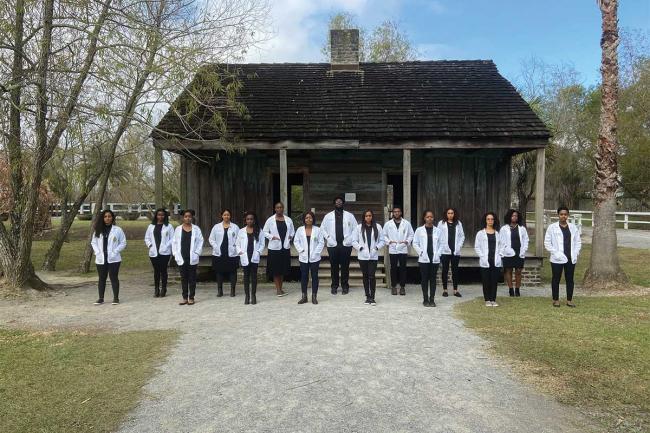“It wasn’t for the public. It was for us,” he said, adding, “I knew it would be iconic.”
The slave quarters are housed on the site of one of the few plantations dedicated to recounting the experiences of slaves in the antebellum South. Ledet had been overwhelmed by his experience visiting the site that summer (2019) with his 9-year-old daughter. He wanted his fellow classmates in SNMA to see their own path to becoming a physician in the profound context of those denied a future because of the evils of slavery and its lasting legacy.
The publicity surrounding the photos spurred a national conversation about Black excellence and the need for greater representation in medicine for people of color.
African Americans make up 13% of the population in the United States, but account for only 5% of doctors and less than 7% of medical students, according to the Association of American Medical Colleges.
The Tulane students formed a nonprofit called The 15 White Coats to get as many as 100,000 of the photos in kindergarten through 12th-grade schools across the country to inspire more young Black students to pursue their dreams in medicine, as well as raise money to help medical school applicants of color pay for the application process, which can cost between $3,500 to $10,000 per student.
“We want to change kids’ perception of who can be a doctor, as well as help with the economic burden of applying to medical school,” Ledet said.
Commitment to More Students of Color
It’s a sentiment that administrators at Tulane University School of Medicine are solidly behind.
After the students’ story went viral, Tulane School of Medicine Dean Dr. Lee Hamm provided media with a statement that said, “These are powerful images. Our students are our greatest strength, and we applaud their sense of purpose, community and service.”
Hamm also sent a message to all students, staff and faculty recognizing the poignant photos, reiterating the school’s commitment to recruiting more students of color.
“Increasing the number of students who are African American or otherwise underrepresented, and supporting them once they are here, is a top priority of our school and the university as a whole,” Hamm said. “While the numbers are improving, we know we have a lot more work to do.”
In speaking with reporters about Tulane, Ledet and his classmates repeatedly singled out one person they said was key to their success at medical school — Bennetta Horne, director of the Office of Multicultural Affairs at Tulane University School of Medicine.
Horne recruited many of the students in the photos. For the past five years, she has been working to make sure classes are more diverse and better reflect the patient population students will eventually serve once they become doctors. She has spearheaded efforts to recruit more students of color and to create a supportive environment for them to succeed once they get to campus.
In 2013, almost 7% of the first-year class at Tulane School of Medicine identified as students of color. Now, more than 26% of the 190 students in the first-year class are students of color. In 2013, only 2% identified as African American or Black. That has grown to 11% in 2019.
“[Horne] knows every last one of us by name. She’s the reason why we are here. That is why we are such champions for her,” Ledet said. “It’s one thing to recruit people of color to your school; it is another thing to keep them there and create an environment that allows them to thrive.”
K-12 schools may sign up for a free #15WC 24-inch by 36-inch poster at the 15 White Coats nonprofit website, the15whitecoats.org.































































